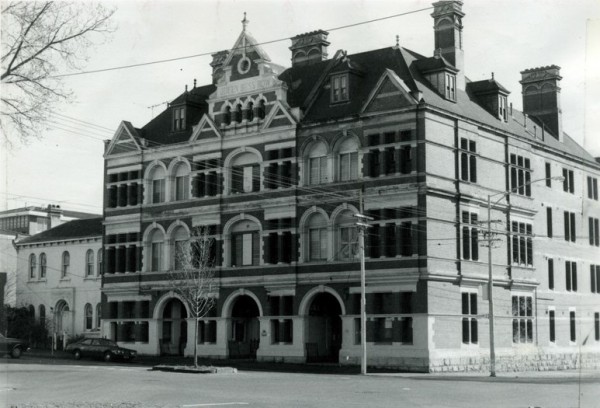East Melbourne, Hotham Street 072, 074, 076, Queen Bess Row
- first
- ‹ previous
- 137 of 272
- next ›
- last
Three four storey houses of red brick with sandstone dressings built in the Queen Anne Revival style. Elaborate facade details (for further, see Australian Heritage Place Inventory, website below).
The land on which Queen Bess Row was built was bought in the original land sales of 1853 by WJT Clarke. In 1895 his son, Joseph Clarke (brother of Sir William Clarke, bart. of Cliveden), is listed as the owner. He died the same year and the property was held by the Clarke Trustees.
However the Notice of Intention to Build gave the name of the owner as a Miss Cornwall. It was for three four storey houses, although it seems the building was not intended to function in this way and the plan was merely a fallback position. The party walls between the houses were designed with archways between them to allow for easy opening up or closing off.
The caption to an illustration in The Building & Engineering Journal, 21 July 1888, describes the building as the East Melbourne Coffee Palace, and this name is also written below the central gable of the building. However it appears that while a coffee palace was the intended usage it was never the reality.
The building, under the management of Miss Henrietta Rebecca Macartney, initially became The East Melbourne Trained Nurses' Home, and by 1890 was also a private hospital. The Argus carried the following advertisement:
'MISS MACARTNEY begs to intimate to the members of the medical profession that she has made all the necessary arrangements for carrying out the HYDROPATHIC TREATMENT of disease. Including steam, hot air, and douche baths at her private hospital, Rubra, Hotham-street, East Melbourne, and has engaged the services of an experienced masseur, who will carry out the doctor’s instructions.'
Advertisements for both the Nurses' Home and the hospital ran until 1894.
On 15 October, 1895 The Argus ran an extensive advertisement for the sale of contents of Rubra, including domestic furniture and hospital equipment. In 1894 Miss Macartney had been sued for negligence. Damages awarded against her were 25 pounds; this plus the bad publicity may have been enough to cause the hospital's closure.
It was also the same year that Joseph Clarke, the building's owner, died. However the house was not immediately sold after Macartney's departure, and was advertised To Let. The inventory amongst Clarke's probate papers describes the building as 'a Brick and Stone building used as a Private Hospital' and valued at 6,000 pounds. Miss Macartney owed rent of 143 pounds and 16s. 8d.
The archways were blocked up in 1896, and the building was converted to apartments with one apartment on each floor of each house. Although not built as apartments the building is regarded as possibly Melbourne's first apartment block.
By the the late 1920s the buildings were known as Rubra Flats (72), Angus McArthur's boarding house (74), and Cregh Flats (76). By 1936 No. 74 was known as Tudor Guest House.
In 1989 the building ceased operating as a 50-room boarding house, home to low-income tenants. Following prolonged feuding between the Ministry of Housing and the Melbourne City Council, and amid much opposition from tenants, would-be tenants and their defendants, the building remained empty for a year. In 1990, it was finally subdivided into three separate houses and sold to individual purchasers.
1886-1895: Joseph Clark, brother of Sir William John Clarke of Cliveden and Rupertswood.
Miss Cornwall: It has been established that Miss Cornwall was Miss Alice Cornwell, daughter of George Cornwell, contractor and builder of Melbourne Grammar. At the time Queen Bess Row was being built she had acquired international fame as the founder of the Midas Gold Mine from which had been extracted one of the largest nuggets ever found, the Lady Loch, weighing around 17.49kg. She quickly became known as Madam Midas and Fergus Hume wrote a book of that name which was inspired by her story. [For more on Alice Cornwell and her connection to Queen Bess Row see EMHS Newsletter March 2013, link below.] It appears, although this is yet to be confirmed, that Miss Cornwell bought the land from Clarke on a long settlement giving her the right to call herself the owner and the right to develop the land. The plan no doubt was to build the houses, establish a company which would buy them from her enabling her to pay the balance of the money owing to Clarke. However the company did not eventuate, settlement was never completed and Clarke retained ownership of the land, now improved with three very large houses.
1889-1895: Henrietta Rebecca Macartney (c.1837-1919). Miss Macartney was the eldest daughter of The Very Reverend Hussey Burgh Macartney, first dean of Melbourne. She was born in Ireland and arrived in Melbourne with her family in 1848. She died at her home, Rubra, 22 Derby Street, Kew.
Australian Heritage Place Inventory: http://www.heritage.gov.au/ahpi/index.html
Lewis, Miles, Suburban Backlash, Bloomings Books, Hawthorn, Vic., 1999
Rushen, Liz. A short untitled MS on the history of the houses written as a caption for an exhibition of photos:
EMHS emvf244
The Argus, 2 Nov 1889, p.8, col.1; 9 May 1890 p.10, col.1; 24 Dec 1894, p.1, Births; 7 Mar 1894, p.8; 30 May 1895, p.3; 15 Oct 1895, p.2; 26 Sept 1919, p.1, Deaths.
Inventory in the Will of Joseph Clarke, 57/792. PROV: VPRS28;P0002;407
The Age, 2 Dec 1988, p.34: https://news.google.com/newspapers?id=JpxVAAAAIBAJ&sjid=EpcDAAAAIBAJ&pg=...
Queen Bess House renovation: https://www.e-architect.co.uk/melbourne/queen-bess-house-in-east-melbourne
- first
- ‹ previous
- 137 of 272
- next ›
- last


